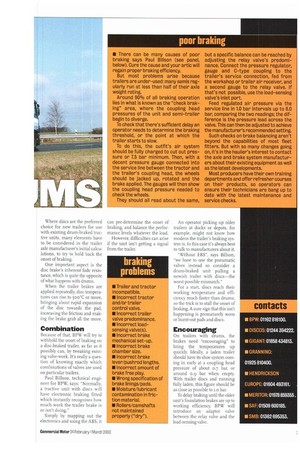poor braking
Page 39

If you've noticed an error in this article please click here to report it so we can fix it.
• There can be many causes of poor braking says Paul Billson (see panel, below). Cure the cause and your artic will regain proper braking efficiency.
But most problems arise because trailers are under-used: many semis regularly run at less than half of their axle weight rating.
Around 90% of all braking operation lies in what is known as the "check braking" area, where the coupling head pressures of the unit and semi-trailer begin to diverge.
To check that there's sufficient delay an operator needs to determine the braking threshold, or the point at which the trailer starts to slow.
To do this, the outfit's air system should be fully charged to cut out pressure or 7.5 bar minimum. Then, with a decent pressure gauge connected into the service line between the tractor and the trailer's coupling head, the wheels should be jacked up, rotated and the brake applied. The gauges will then show the coupling head pressure needed to check the wheels.
They should all read about the same, but a specific balance can be reached by adjusting the relay valve's predominance. Connect the pressure regulator, gauge and C-type coupling to the trailer's service connection, fed from the workshop or trailer air receiver, and a second gauge to the relay valve. If that's not possible, use the load-sensing valve's inlet port.
Feed regulated air pressure via the service line in 1.0 bar intervals up to 6.0 bar, comparing the two readings; the difference is the pressure lead across the valve. This can then be adjusted to achieve the manufacturer's recommended setting.
Such checks on brake balancing aren't beyond the capabilities of most fleet fitters. But with so many changes going on, it's in the haulier's interest to contact the axle and brake system manufacturers about their existing equipment as well as the latest developments.
Most producers have their own training departments and offer refresher courses on their products, so operators can ensure their technicians are bang up to date with the latest maintenance and service checks.












































































































